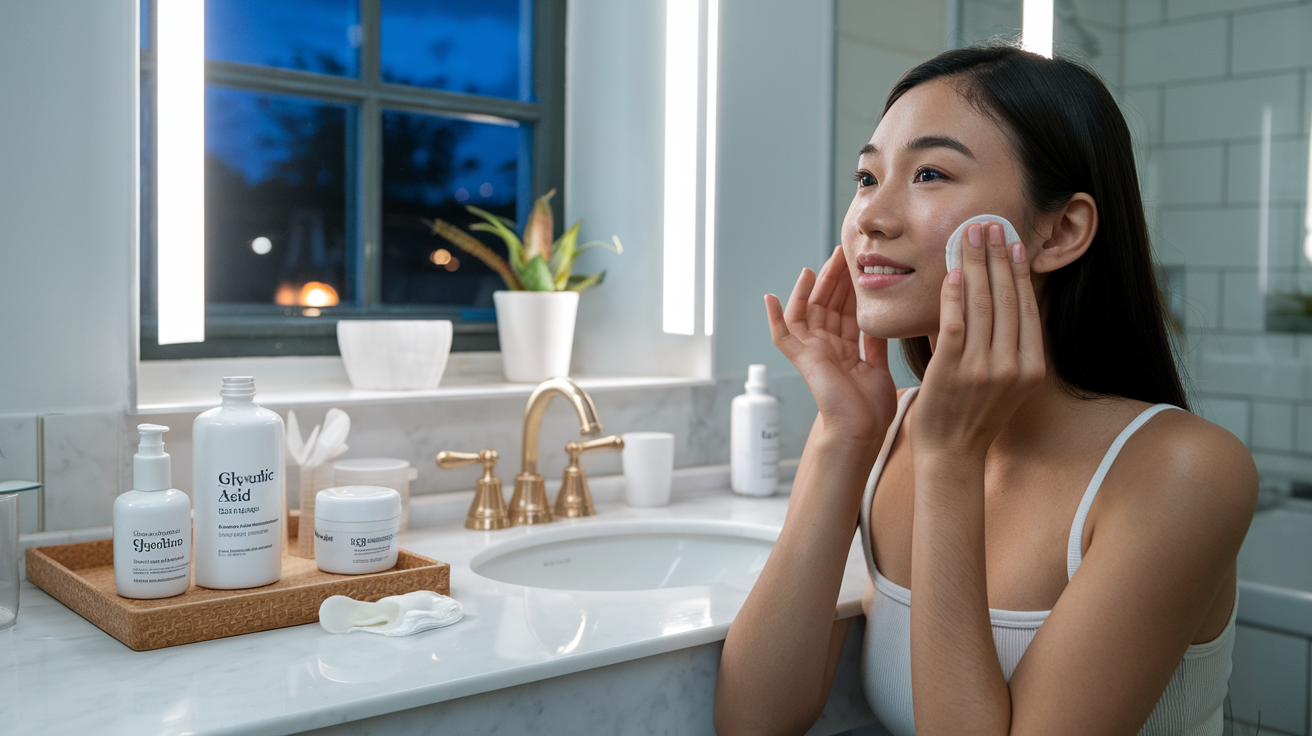
Ever slathered glycolic acid on your face right before a big event, only to end up with skin that looks like it’s been through a war? Yeah, been there.
The timing of when you apply glycolic acid can literally make or break your skin game. It’s not just about slapping it on whenever you feel like playing chemist in your bathroom.
Knowing exactly when to put glycolic acid on face is crucial whether you’re dealing with stubborn acne scars or just want that glow that makes people ask what you’ve been doing differently.
But here’s the real kicker – most people are using it at completely the wrong time of day, sabotaging their results without even realizing it.
Understanding Glycolic Acid: The Skin Transformation Expert
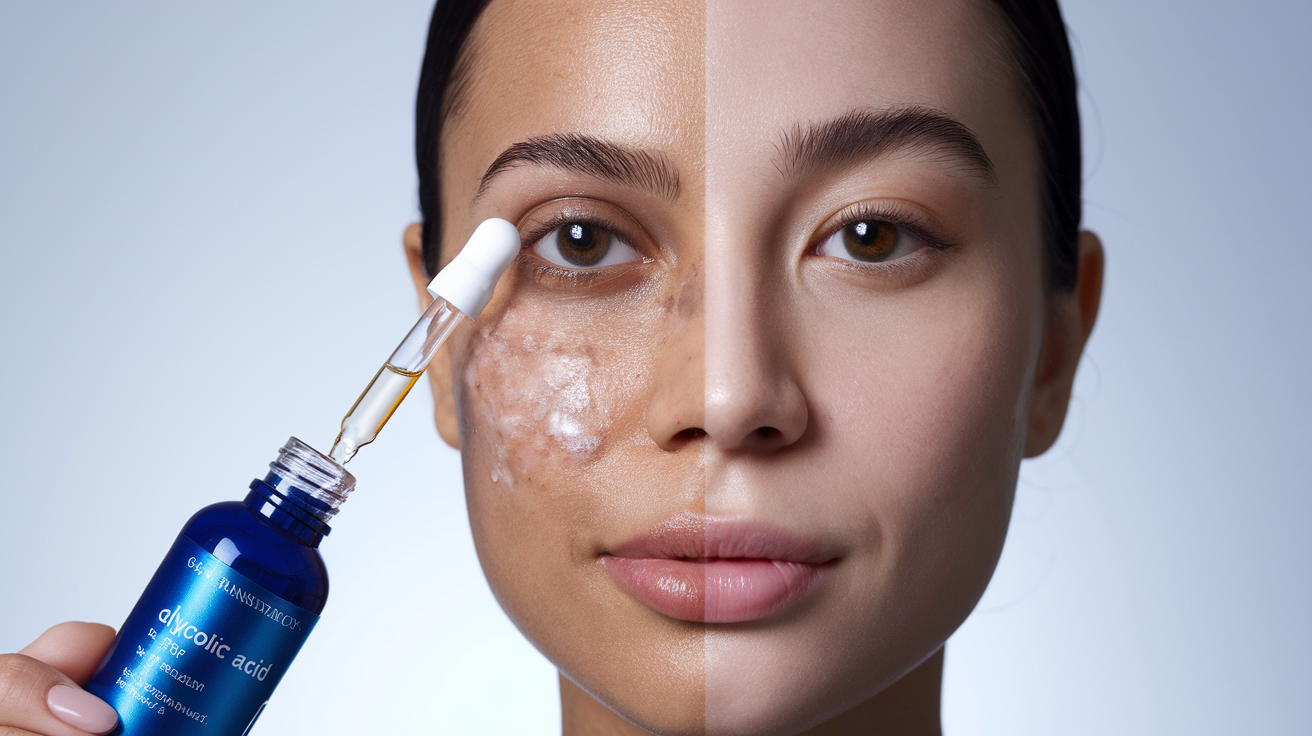
What is Glycolic Acid and How Does it Work?
Glycolic acid is the superstar of the alpha-hydroxy acid (AHA) family. With the smallest molecular size of all AHAs, it penetrates your skin like nobody’s business. Think of it as that efficient friend who gets things done while everyone else is still making plans.
So what’s happening when you slather this stuff on your face? Glycolic acid works by dissolving the bonds between dead skin cells (technically called “corneocytes” if you want to impress someone at your next dinner party). This exfoliation process reveals the fresher, brighter skin underneath.
The magic happens because glycolic acid is water-soluble and has that tiny molecular structure. It slips right through your skin’s barrier, gets down to the deeper layers, and stimulates collagen production. Your skin literally rebuilds itself faster when glycolic acid is around.
Benefits for Your Facial Skin
Who doesn’t want that glow-from-within look? Glycolic acid delivers:
- Smoother texture (goodbye rough patches!)
- Brighter complexion
- Reduced appearance of fine lines
- Fewer breakouts
- Faded hyperpigmentation
- Smaller-looking pores
The real game-changer is how glycolic acid tackles multiple skin concerns simultaneously. While you’re treating those dark spots, you’re also getting anti-aging benefits. While fighting acne, you’re also improving texture. It’s skincare multitasking at its finest.
For aging skin, glycolic acid is particularly effective because it stimulates collagen production. Your skin naturally produces less collagen as you age, but glycolic acid tells your skin cells, “Hey, time to make more of that bouncy, firm stuff!”
Different Concentrations and Their Effects
Not all glycolic acid products are created equal. The concentration makes a massive difference:
| Concentration | Best For | What to Expect |
|---|---|---|
| 5-7% | Beginners, sensitive skin | Gentle exfoliation, minimal irritation |
| 8-10% | Regular users, normal skin | Noticeable smoothing, some tingling |
| 12-15% | Experienced users | Significant results, potential redness |
| 20-30% | Professional treatments only | Dramatic results, downtime required |
Start low and slow if you’re new to glycolic acid. Your skin needs time to adjust, and diving into the deep end with high concentrations is a recipe for irritation.
The pH level matters too. Lower pH (more acidic) products are more effective but potentially more irritating. Most over-the-counter products have a pH of 3.5-4 to balance effectiveness with safety.
Potential Side Effects to Be Aware Of
Glycolic acid is powerful stuff, and with great power comes… you know the rest.
Common side effects include:
- Redness and irritation (especially when first starting)
- Dryness and flaking
- Increased sun sensitivity
- Temporary breakouts (purging)
Your skin becomes more vulnerable to UV damage when using glycolic acid, so sunscreen isn’t optional—it’s mandatory. Skip this step, and you’re undoing all the good work and potentially causing more damage.
The “purging” phase throws many people off. As glycolic acid speeds up cell turnover, it can bring existing clogs to the surface faster. This might look like more breakouts initially, but it’s actually clearing congestion that was already there.
For those with darker skin tones, proceed with extra caution. Higher concentrations can potentially cause post-inflammatory hyperpigmentation if your skin gets irritated.
Optimal Times to Apply Glycolic Acid
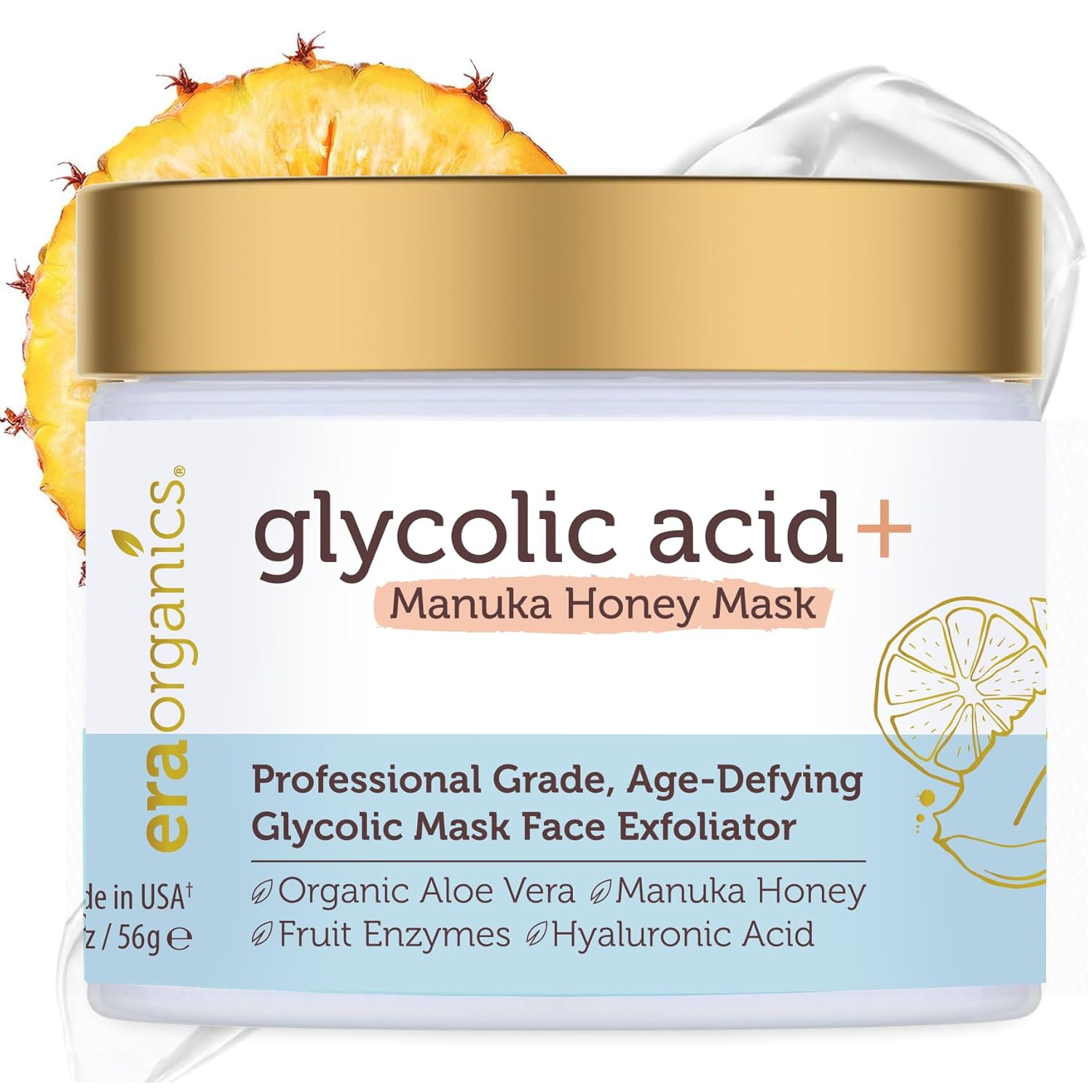
Nighttime Application: Why Evening is Often Best
Timing is everything with glycolic acid. Nighttime is hands down the best time to slap on this exfoliating superhero. Why? Your skin goes into repair mode while you sleep, making it the perfect opportunity for glycolic acid to work its magic without interference.
At night, you’re not exposing freshly exfoliated skin to harmful UV rays, which is huge because glycolic acid can increase sun sensitivity. Nobody wants to deal with that extra sunburn risk! Plus, your skin naturally loses more water at night, so any hydrating products you apply after your glycolic acid will penetrate deeper.
Many people notice some redness or slight tingling after application – definitely not something you want to sport during your morning Zoom calls! By morning, these effects typically disappear, leaving you with that glow everyone will envy.
Morning Application: When It Makes Sense
Morning application isn’t totally off the table. If you’re using a super low concentration (think 5% or less), your skin is non-sensitive, and you’re religious about sunscreen application, morning use can work.
Some benefits to morning application:
- Creates a smoother canvas for makeup
- Helps control oil throughout the day
- Can boost the effectiveness of vitamin C serums applied afterward
Just remember: if you go the morning route, sunscreen isn’t optional – it’s absolutely non-negotiable!
Seasonal Considerations: Summer vs. Winter Usage
Your glycolic acid schedule should change with the seasons. Smart skincare isn’t static!
| Season | Recommended Usage | Why It Works |
|---|---|---|
| Summer | 1-2 times weekly, nighttime only | Higher UV exposure increases sensitivity risks |
| Winter | 3-4 times weekly, can be more flexible | Less sun exposure, skin tends to be drier and needs more exfoliation |
During summer months, your skin naturally exfoliates faster due to heat and humidity, so you don’t need as much help. Winter’s dry air creates a buildup of dead skin cells that glycolic acid can effectively tackle.
During Specific Skin Conditions: When to Proceed with Caution
Your skin talks – listen to it! Skip glycolic acid completely when dealing with:
- Active breakouts or cystic acne
- Sunburn or windburn
- After procedures like microdermabrasion
- During rosacea flare-ups
If you’ve got sensitive skin but still want the benefits, try the “sandwich method” – apply moisturizer, then glycolic acid, then moisturizer again. This buffers the acid’s intensity while still giving results.
Pregnant? Check with your doctor first, but many recommend avoiding stronger concentrations during pregnancy.
Remember: the path to glowing skin isn’t about maximum strength or frequency – it’s about consistency and respecting your skin’s boundaries!
Creating Your Perfect Glycolic Acid Routine
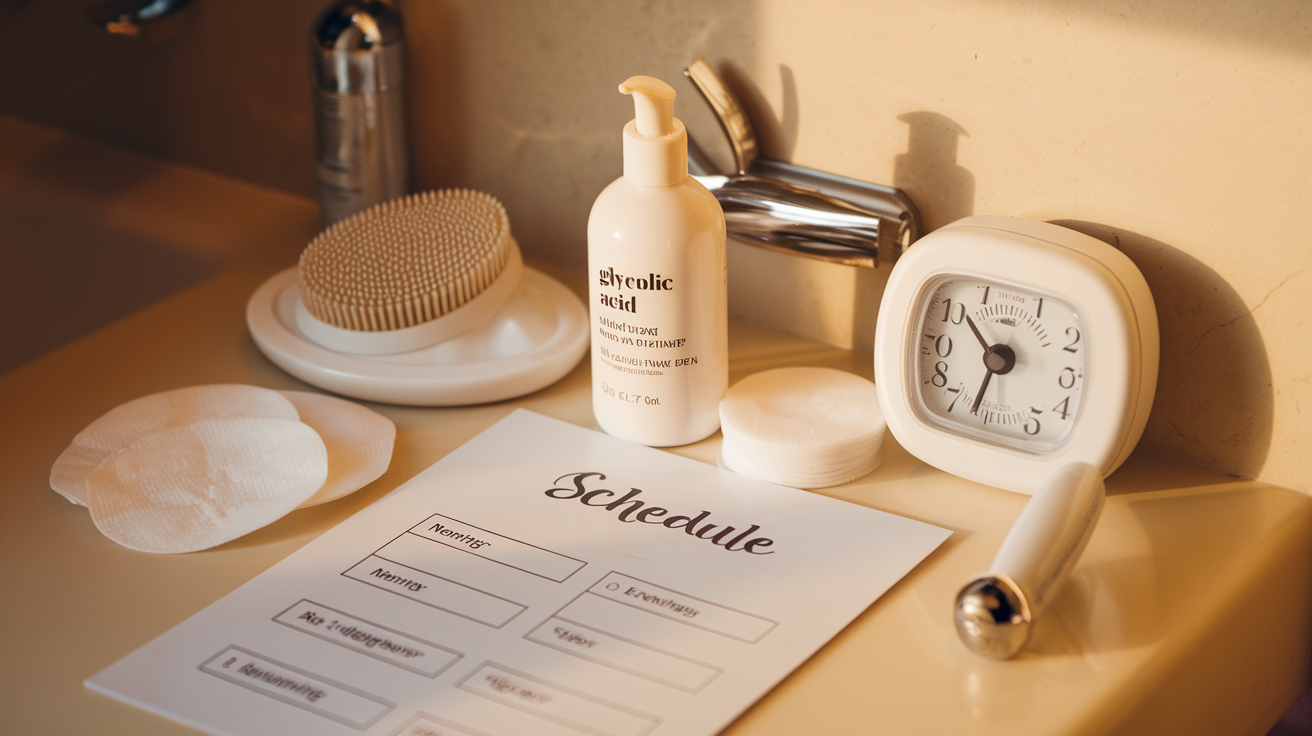
A. Beginner’s Schedule: Starting Slow for Best Results
Got new glycolic acid products? Pump the brakes before slathering it all over your face every night. Your skin needs time to adjust to this powerful exfoliant.
For beginners, here’s your starter plan:
- Week 1-2: Apply just once a week in the evening
- Week 3-4: If your skin’s happy, bump up to twice weekly
- Month 2: For most skin types, 2-3 times weekly is the sweet spot
Always apply glycolic acid to clean, dry skin. Wait 15-30 minutes before applying other products to let it work its magic without interference.
B. Advancing Your Usage: Building Tolerance Safely
Ready to level up? Smart move to go gradual:
- Monitor your skin’s response after each application
- Increase frequency by one application per week
- Consider moving to higher concentrations only after 3+ months of consistent use
Most people max out at 3-4 times weekly, even with experienced skin. If you’re using a 5% concentration and handling it well, you might try 7% or 10% – but never jump more than one level at a time.
C. Frequency Guidelines Based on Skin Type
Your skin type dictates your ideal schedule:
| Skin Type | Recommended Frequency | Concentration |
|---|---|---|
| Oily/Acne-Prone | 2-3 times weekly | 5-10% |
| Normal | 1-2 times weekly | 5-7% |
| Combination | 1-2 times weekly | 5-7% |
| Dry | Once weekly | 5% or less |
| Sensitive | Once every 10-14 days | 5% or less |
D. Signs It’s Time to Take a Break
Your skin will wave red flags when it’s had enough:
- Persistent redness that doesn’t fade
- Unusual tightness or discomfort
- Flaking beyond the normal “purging” phase
- Increased sensitivity to products you normally tolerate
- Burning sensation (not the typical tingle)
If any of these pop up, stop using glycolic acid immediately and focus on gentle, hydrating products until your skin barrier recovers.
E. Combining with Your Existing Skincare Routine
Glycolic acid plays well with some ingredients and fights with others:
Good Combinations:
- Hyaluronic acid (adds hydration)
- Niacinamide (reduces irritation potential)
- Peptides (in separate applications)
Avoid Using Together:
- Retinol/Retinoids (use on alternate nights)
- Vitamin C (use glycolic at night, vitamin C in the morning)
- Other exfoliants (AHAs, BHAs, enzymes)
A smart evening routine might look like: cleanser → glycolic acid → wait 20 minutes → hydrating serum → moisturizer. On glycolic nights, skip any other active ingredients and focus on barrier support.
The Right Way to Apply Glycolic Acid
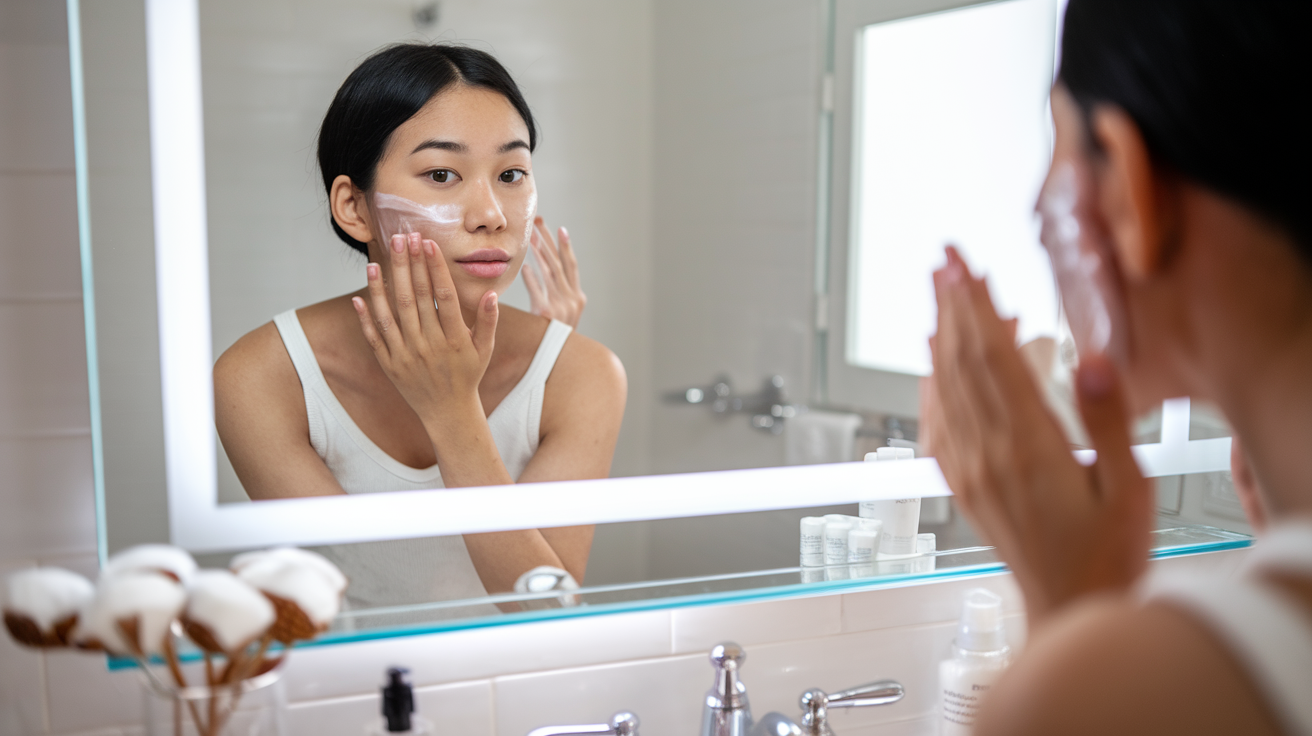
Essential Pre-Application Steps
Okay, before you slather glycolic acid all over your face, there are some crucial prep steps. First things first – clean your face thoroughly with a gentle, pH-balanced cleanser. You want a clean canvas without any makeup, sunscreen, or daily grime that could prevent the acid from working its magic.
Pat your skin dry – and I mean really dry. Glycolic acid works best on dry skin. If your face is damp, it actually enhances penetration, which might sound good but can lead to irritation for beginners.
Timing matters too. The best time to apply glycolic acid is typically at night. Why? Because it can make your skin more sensitive to sunlight. Plus, your skin’s natural repair process happens while you sleep – perfect timing to let glycolic acid do its thing.
Wait about 15-20 minutes after washing your face. This gives your skin’s pH time to normalize and prevents that intense stinging sensation that nobody enjoys.
Application Techniques for Maximum Benefits
Less is definitely more when starting with glycolic acid. A pea-sized amount is plenty for your entire face. Seriously.
Apply in a specific order: forehead first, then cheeks, nose, chin, and finally neck (if you’re using it there). Avoid the delicate eye area and lips completely – they’re too sensitive and don’t need this level of exfoliation.
For beginners, try the press-and-roll technique: gently press the product onto your skin rather than rubbing it in. This minimizes irritation while ensuring even coverage.
If you’re using a glycolic acid toner, apply with a cotton pad using upward strokes. For serums or creams, use your fingertips and apply in gentle, upward motions.
Most importantly, don’t layer multiple acid products in the same routine. Choose either your glycolic acid OR other AHAs/BHAs for that session. Your skin barrier will thank you.
Post-Application Care to Minimize Irritation
After applying glycolic acid, patience is key. Wait a full 10-15 minutes before applying any other products. This gives the acid time to work at its optimal pH level before being neutralized.
Follow up with a hydrating, non-comedogenic moisturizer. Look for soothing ingredients like ceramides, hyaluronic acid, or niacinamide – they’re perfect partners to counter any potential irritation.
The morning after using glycolic acid? Sunscreen is non-negotiable. I’m talking minimum SPF 30, broad-spectrum protection. Your freshly exfoliated skin is extra vulnerable to UV damage.
If you notice any redness or irritation, try the sandwich method: apply a light moisturizer before your glycolic acid, then another layer of moisturizer afterward. This creates a buffer that reduces irritation without completely blocking the benefits.
Cool tip: Keep your glycolic acid products in a cool, dark place. Heat and light can degrade the formula over time, making it less effective or more irritating.
Patch Testing: Your Safety First Approach
Never, and I mean never, skip patch testing with glycolic acid. Even if you’re the most impatient person on the planet (I get it), this step could save you from a face full of regret.
Here’s how to do it right: Apply a small amount behind your ear or on your inner forearm. Wait 24-48 hours and check for any adverse reactions like redness, burning, or itching.
For face-specific testing, try the jawline method. Apply a tiny amount along your jawline where reactions are less noticeable but still indicate how your facial skin will respond.
What to watch for:
- Mild tingling = normal
- Burning pain = not normal
- Slight redness that fades quickly = okay
- Persistent redness, swelling, or itching = stop immediately
Remember that sensitivity can develop over time, so periodically patch test even if you’ve used glycolic acid before. Seasonal changes, hormonal fluctuations, and medication can all affect how your skin responds to acids.
When to Avoid Using Glycolic Acid
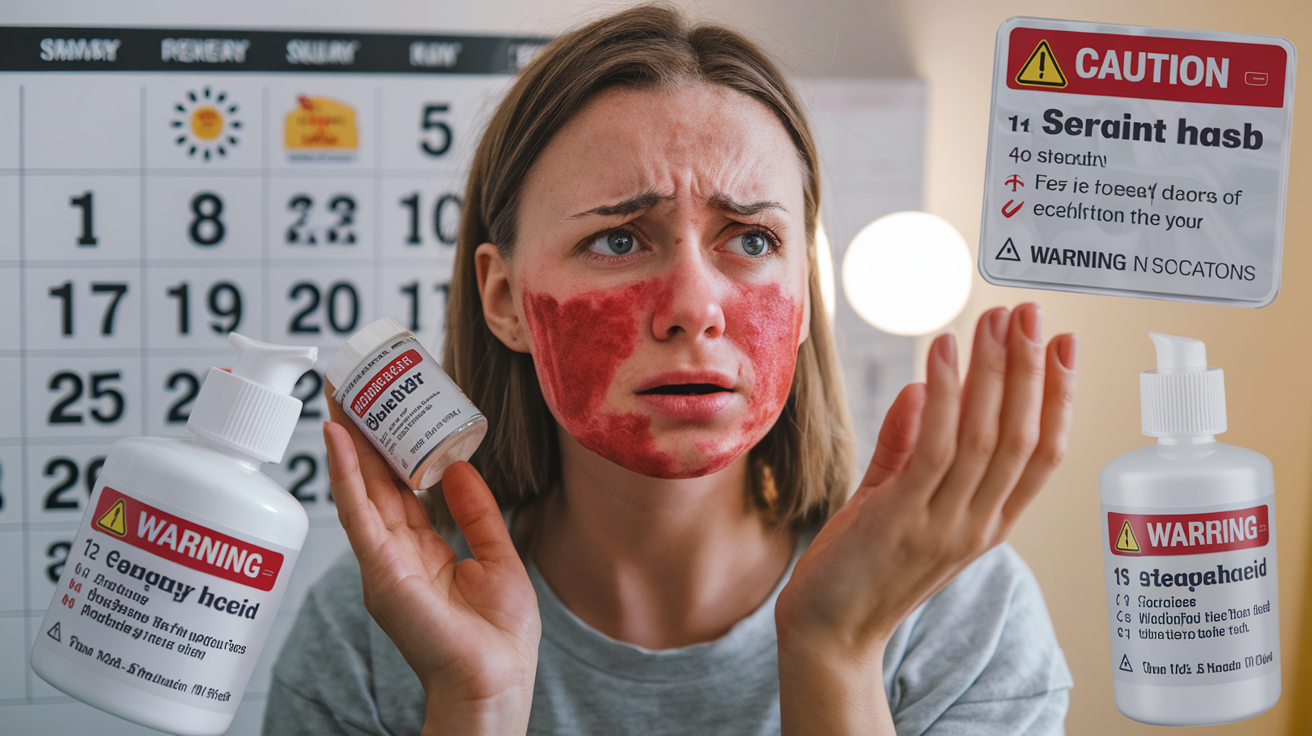
A. Incompatible Skincare Ingredients to Separate
While glycolic acid works wonders, it doesn’t play nice with everyone in your skincare cabinet. Mixing it with certain ingredients is like inviting two feuding relatives to the same dinner party—chaos ensues.
Avoid using glycolic acid alongside:
- Retinoids: These two powerhouse ingredients can tag-team to irritate your skin. Space them out—use retinol at night and glycolic acid in the morning, or alternate days.
- Vitamin C: When these acids meet, they cancel each other out. One becomes less effective, and your skin gets confused about which job to do first.
- Other AHAs/BHAs: Layering multiple acids is overkill. Your skin barrier will wave the white flag in surrender.
- Benzoyl Peroxide: This combo can cause excessive dryness and irritation that not even your heaviest moisturizer can fix.
B. Skin Conditions That Require Postponing Use
Got any of these going on? Hit pause on the glycolic acid:
- Active breakouts: If you’re in the middle of an angry breakout war, glycolic acid might just fan the flames.
- Sunburn: Your skin is already damaged and needs recovery time, not exfoliation.
- Rosacea flares: During active flare-ups, glycolic acid can trigger more redness and inflammation.
- Eczema or psoriasis patches: These conditions involve compromised skin barriers that glycolic acid will only weaken further.
- Windburn or extreme dryness: Your skin needs moisture and repair, not the exfoliating kick of glycolic acid.
C. Before Sun Exposure or Outdoor Activities
Glycolic acid and sunshine don’t mix well. This acid removes dead skin cells, leaving newer, more vulnerable skin exposed to UV damage.
Skip glycolic acid:
- The morning before a beach day
- Before hiking or outdoor sports
- During vacation in sunny destinations
- Any day you know you’ll spend significant time outdoors
If you must use glycolic acid during sunny seasons, make it a nighttime-only ritual and double down on SPF the next day. We’re talking SPF 30 minimum, reapplied every two hours.
D. During Certain Medical Treatments or Procedures
Some medical treatments require giving glycolic acid a timeout:
- After laser treatments: Your skin needs 1-2 weeks to recover first.
- Post-microdermabrasion: Wait at least 3-5 days before reintroducing acids.
- During accutane treatment: This medication already thins your skin—adding glycolic acid is just asking for trouble.
- Following chemical peels: Your skin just had a major exfoliation; it doesn’t need another one.
- Post-surgery: Any facial surgery or procedure requires gentle care during healing, not chemical exfoliation.
Always check with your dermatologist about when it’s safe to resume using glycolic acid after procedures.
E. Pregnancy and Breastfeeding Considerations
The pregnancy glow doesn’t need glycolic acid’s help—and it might be better that way.
While topical glycolic acid in low concentrations (under 10%) is generally considered okay during pregnancy, many doctors still recommend avoiding it entirely, especially during the first trimester.
Why the caution? There’s limited research on how glycolic acid might be absorbed through the skin and affect pregnancy. Better safe than sorry.
During breastfeeding, the same conservative approach applies. Though the risk of absorption into breast milk is low, many medical professionals suggest waiting until after breastfeeding to restart your glycolic acid routine.
Pregnancy-safe alternatives include:
- Lactic acid (milder AHA)
- Azelaic acid (FDA-approved during pregnancy)
- Gentle physical exfoliants
Always discuss your skincare routine with your OB-GYN or dermatologist during pregnancy and breastfeeding.

Timing is everything when it comes to using glycolic acid for your skincare routine. For optimal results, apply glycolic acid products in the evening after cleansing and before moisturizing, as this allows the acid to work effectively overnight while minimizing sun sensitivity. Always follow up with sunscreen during daytime hours, and pay attention to your skin’s response, adjusting frequency based on your skin type and tolerance.
Remember that glycolic acid isn’t suitable for every situation – avoid using it when your skin is irritated, sunburned, or when using other potent active ingredients like retinol in the same routine. By understanding when and how to incorporate glycolic acid into your skincare regimen, you can maximize its exfoliating and rejuvenating benefits while maintaining healthy, glowing skin. Start slowly, listen to your skin, and enjoy the transformative results of this powerful alpha hydroxy acid.
